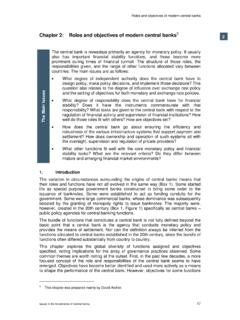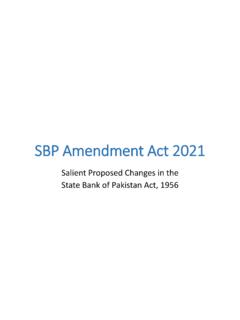Transcription of FINANCIAL PERFORMANCE ANALYSIS OF PRIVATE …
1 I FINANCIAL PERFORMANCE ANALYSIS OF PRIVATE COMMERCIAL BANKS OF ETHIOPIA: CAMEL RATINGS Mr. MELAKU ALEMU Lecturer, Dire Dawa University Mr. MELAKU AWEKE Lecturer, Dire Dawa University ABSTRACT This study sought to analyze the overall PERFORMANCE of PRIVATE commercial banks in Ethiopia using CAMEL rating approach. In this study, the FINANCIAL PERFORMANCE of six sampled PRIVATE banks was measured using the audited FINANCIAL reports of 10 years period (2007-2016). Novel feature of this study was the inclusion of more explanatory variables, which were not used by the average researchers fixed asset to total assets, net profit per employee, total deposit per no. branches, total loan per no. of branches, measurements.
2 The collected data were analyzed using both descriptive and inferential statistical tools. The descriptive statistics tools used to rate the overall PERFORMANCE of the bank , while panel regression model was used to measure the impact of CAMEL elements on bank PERFORMANCE ROA and ROE. As per the composite rating of CAMEL, the finding of the study revealed that NIB bank stood on the top followed by United bank , while Awash bank and bank of Abyssinia stood the least. On both panel model estimations, LEVRAGE, NIEGE, NPEP, TDBRA, TLBRA, NIITA, and LATD explanatory variables were significant in determining the profitability indicators-ROA and ROE. No asset quality indicators were significant in determining the profitability ratios.
3 Key words: CAMEL, ROA, ROE, PRIVATE Commercial Banks, and EthiopiaInternational Journal of Scientific and Research Publications, Volume 7, Issue 10, October 2017 ISSN 2250-3153 1. INTRODUCTION BACKGROUND OF THE STUDY FINANCIAL sectors play crucial role in economic growth and industrialization via channeling funds from surplus units" the depositors, to the deficit units, the borrowers, in the process gaining from the spread of the different interest charged. Their intermediation role can be said to be a catalyst for economic growth (Funso, Kolade and Ojo, 2012). The role and importance of banks of modern economy is enormous ( Bikker, 2010; Rashid, 2010; Altan , Beduk and Yusufazari, 2014) and its products/services which it provides growing in terms of depth, the number of institutions and the amount of money that managed by such institutions.
4 The roles of such Banks are paramount in developing countries like Ethiopia where the FINANCIAL market is underdeveloped and none existed. The sector is the backbone of economy in the country (Jain and Jaiswal, 2016). As the banks are interconnected with each other for the payment and other functions, the a failure of a single bank not only affects its shareholders and depositors rather it affects all over the bank (Kumbirai and Webb , 2010) and it creates an economic turmoil situation which is regarded as a disaster for the economy that was viewed in recent global recession that occurred as the result of bank failure at the inception (Al Karim and Alam, 2013). So, banks are exposed to many types of risk that has caused in different situations which result in different level of risks.
5 Such risks include liquidity risk related to inability to meet current demand; credit risk is a default occurs when a borrower does not make the obligated interest and principal payments in a timely manner, interest rate risk (the possibility that the bank will become unprofitable, if rising interest rates force it to pay relatively more on its deposits than it receives on its loans). Zawadi (2013), Mohiuddin (2014) stated that Sound FINANCIAL health of a bank is the guarantee not only to its depositors but is equally important for the shareholders, employees and whole economy as well. The subject of FINANCIAL PERFORMANCE and research into its measurement is well advanced within finance and management fields (Alkhatib, 2012).
6 As Searle (2008) stated the government of all nations should have maximum concern on PERFORMANCE of all banks which are operating in the territory of the country. In consideration of such outcome and concern , the FINANCIAL health of each bank should have been measured from time to time and managed efficiently and effectively (Sangmi & Nazir, 2010). International Journal of Scientific and Research Publications, Volume 7, Issue 10, October 2017 ISSN 2250-3153 There are different stakeholders that have interest in evaluations of the PERFORMANCE of banks including depositors, investors, bank managers and regulators (Ibrahim, 2014). For instance central banks and bank regulators may need to identify and call attention to banks that are experiencing chronic FINANCIAL problems in order that they may fix them before they get out of control.
7 On the other hand, Shareholders need to assess which banks they can deem suitable for financially invest in. The banks evaluate their own PERFORMANCE over a given period so that they may determine the efficacy and long term viability of management decisions or goals so that they can alter the course and make changes whenever it is appropriate. The stage of development of the banking industry is a good reflection of the development of the economy (Misra & Aspal, 2013). To sustain the development of the economy, the PERFORMANCE and health of banks has to be checked and evaluated periodically. There are different approaches used by different regulatory bodies. Among those approaches, most preferred parameters used by the regulators and different scholars are CAMEL (capital adequacy, asset quality, management quality, earnings and liquidity) rating criterion to assess and evaluate the PERFORMANCE and FINANCIAL soundness of the activities of the bank .
8 The CAMEL supervisory criterion in banking sector is a significant and considerable improvement over the earlier criterions in terms of frequency, check, spread over and concentration (Misra & Aspal, 2013; Basel, 2011). Hence, this study intends to analyze the PERFORMANCE of PRIVATE commercial banks in Ethiopia by using CAMEL approach. STATEMENT OF PROBLEM The banking sector s PERFORMANCE is perceived as the replica of economic activities of the economy. The stage of development of the banking industry is a good reflection of the development of the economy (Misra & Aspal, 2013). Evaluation of FINANCIAL PERFORMANCE of the banking sector is an effective measure and indicator to check the soundness of economic activities of a nation.
9 The pioneer researches work by Anteneh, Arega and Yonas, (2011), evaluated the PERFORMANCE of selected commercial banks of Ethiopia using a framework of CAMEL for the period of 2000"2010. They found that independent variables in CAMEL framework have highly explained the PERFORMANCE variables , return on assets and return on equity. The PRIVATE banks were in a better position than the public banks in terms of asset quality, management quality, and earning International Journal of Scientific and Research Publications, Volume 7, Issue 10, October 2017 ISSN 2250-3153 ability, while public banks were better in capital adequacy. However, liquidity position was high for both PRIVATE and public commercial banks. Mulualem (2015) on his evaluation of fourteen commercial banks using panel data and multiple regression for the period of 2010"2014 reveals that Capital adequacy, Asset Quality and Management efficiency have negative relation whereas earning and liquidity shows positive relationship with both profitability measures.
10 The ranking result based Buna international bank ranked first by capital adequacy, asset quality and liquidity ratio while commercial bank ranked first by Management efficiency and Earning ratios respectively and finally Wegagen bank was the first by the composite rate. However, the study conducted by Dakito (2015) using CAMEL approaches for the period 2000"2013 found that NIB s overall PERFORMANCE was good. On similar study by Ermias (2016) has also investigated the effects of internal determinants of profitability of six senior PRIVATE Ethiopian commercial banks of the period 2000"2014 and thereby ranked the overall FINANCIAL PERFORMANCE of the respective banks based on CAMEL model. He noted that bank specific factors incorporated into the CAMEL model affect to the extent of of the changes in profitability of the PRIVATE commercial banks of Ethiopia.















